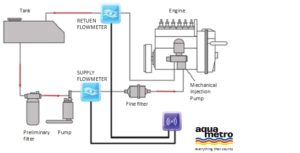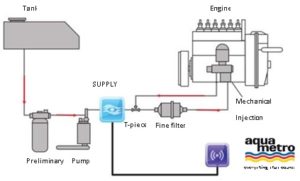Fuel consumption management is the key to vehicle telematics
Abraham Koshy
Product Development & Sales Engineer
Aquametro AG

Road Transport Today
The share of freight transported in the country by roadways has come a long way in the last 60 years. With a little more than 10% share in years 1950-60, road transport boasted of 65% share in freight transport with a whooping tra?c of 668 Billion ton kilometer (BTKM) during 2011-12 . This phenomenal increase is attributed to the corresponding decrease in share of rail transport from 88% to 33% during the same period.
It becomes particularly interesting to note this lion’s share of freight transported by road, despite the fact that road transport is undoubtedly more expensive compared to rail or even to Inland waterways. The National Transport Development Policy Committee (NTDPC) has researched to estimate the freight load by the year 2031-32 and concluded that the load shared by Road will reduce to 30%, with Rail at 50%.
This then calls for making road transport cheaper and staying relevant against other modes of transportation. This can be achieved by better technologies, maintenance and driving practices. It requires special e?orts to cut on the biggest expense for any logistics industry- FUEL!
Case For Reducing Fuel Consumption
Consider the following figures of fuel consumption for a single truck of a private limited company plying in the state of Gujarat for a period of 7 months. These numbers were measured by using the most advanced and reliable technology called di?erential flowmeters (DFM) from Aquametro AG, having accuracy of 99% or more. These figures provide an outlook on the cost of fuel for a typical fleet owner. The fuel cost of 1 truck for 7 months stands at staggering amount of Rs. 5,37,168, which translates to approximately Rs. 9,00,000 annually. Given the fact that the fleet owner owned more than 200 trucks, fuel costs cumulates to Rs. 18,00,00,000!
Consider the following Fuel expenditure figures of few Government run state transport organizations for the year 2013-2014. Given the above astronomical costs for fuel & other factors, none of the organizations could register profit in the said year. It is one thing to boast of fleet size and variety, it becomes another to arrest the losses incurred and reduce the burden on tax payer’s money.
Hence we come to the no-brainer conclusion:
Fuel monitoring can easily assist in saving fuel cost of 1- 15%. Even in worst case, saving just 1% cost is still a very substantial amount to account.
Fuel monitoring- The right way
If fuel is the biggest expense for any logistics company, then monitoring this black gold cannot be done frivolously. Even today, monitoring such an expensive commodity is mostly done by thumb rules based on Engine Model, Vehicle Load, Engine ON hours etc.
For eg, Engine Model X has a rated consumption of 12 l/hr or 3km/ltr. Using either of these slopes, the total consumption is then calculated and adjusted as per the load carried by the vehicle. This method is flawed in its basics as this is not ‘measurement’ but ‘estimation’. There are scores of reasons why the actual figures will be deviant of the calculated figures.
Secondly, this illogically assumes all vehicles of a particular model will be equally efficient. But the fact is, bigger the fleet size, greater is the probability of having under performing vehicles. It is highly unlikely that 2 vehicles of the same model and same year, travelling same distance with same load, will consume same amount of fuel. It is also unreasonable to say this difference will be negligible, as unit rate of Diesel being Rs. 50 /l, this difference is bound to scale and become exorbitant.
Though there are many technologies in the market, much concentration is given to monitoring fuel tank. This is despite the fact that, what is burnt at the engine brings business to the owner, and not necessarily what is filled in the tank. Hence it becomes important to measure consumption and not simply level. To derive consumption by measuring depreciation in tank level will not yield satisfactory and accurate results.
On the other hand, to measure only fuel consumption of the engine, will make the system depend on paper bills and receipts of fuel for analysis. Retrieving the same from fleet owners is a herculean task. The biggest technological challenge for telematics systems will be to bridge the gap of information between fuel filling and fuel consumption. Hence a system which involves sensors to measure both these information, and also possess smart algorithms to analyze and relate these information together, will be accurate and completely independent of human assistance or interference.
Measuring fuel consumption The most reliable and accurate technology to measure fuel consumption is DFM (Differential Flow Measurement). Its principally based on traditional flowmeters, but customized for fuel and optimized to tolerate the vibrational environment of the engine. Consider the following two methods of measurement.

Majority of vehicles in India will feature two fuel lines for an engine. The supply line, carries fuel from the tank to the engine, via a filter and pump. The injection pump deciding on the basis of the load of the engine, returns some volume of fuel to the tank, through the return line. During idling, generally 80% of fuel returns to the tank and only 20% is consumed at the engine. Hence, measuring the difference between the volume of fuel injected into the engine and that which is returned to the tank will accurately give us fuel burned at the engine.
This method will require 2 flowmeters. GPS hardware acts like a data acquisition devise, receiving this information; which is then sent to the server. Calculating difference between supply and return flow is done at the server, while generating reports. Consumption= Supply flow- Return Flow. In rare cases, the return line does not return to the tank, but is made to re- circulate back to the engine. Hence the flow through the supply flowmeter will be completely consumed at the engine. Consumption= Supply flow.

The Challenge
Ignorance among end users will play a challenge in the integration of fuel sensors with existing telematics o?erings. Moreover, given the price sensitiveness of the market, inclusion of sensors into vehicle tracking hardware is highly deterred by vehicle tracking players. Hence the Indian market is not yet matured for developing and selling a complete system of fuel sensors. Though inclusion of fuel module in a vehicle tracking device exponentially increases the return of investment; end users are still weary of the higher capital cost in procuring such telematics device & it’s sensors. Therefore they would very often settle for plain vanilla tracking. Nevertless, the importance to save fuel will only increase with passing time and to develop an economical solution will be the key to meet this challenge.


